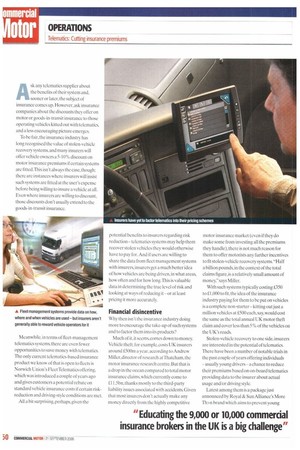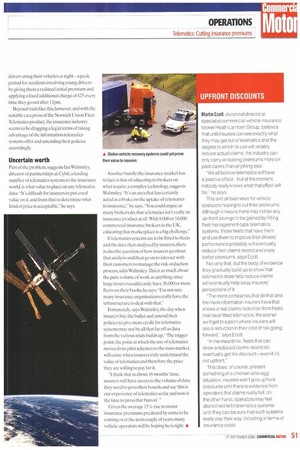Telematics has great potential for reducing insurance costs, but tangible
Page 49

Page 50

Page 51

If you've noticed an error in this article please click here to report it so we can fix it.
discounts can be hard to come by for fleet operators. Why is this and when might the situation begin to change? Robin Meczes reports.
Ask any telematics supplier about the benefits of their system and, sooner or later, the subject of insurance comes up. However, ask insurance companies about the discounts they offer on motor or goods-in-transit insurance to those operating vehicles kilted out with telematies, and a less encouraging picture emerges.
To be fair, the insurance industry has long recognised the value of stolen-vehicle recovery systems. and many insurers will offer vehicle owners a 5-10% discount on motorinsurance premiums if certain systems arc fitted.This isn't always the case, though: there are instances where insurers will insist such systems are fitted at the user's expense before being willing to insure a vehicle at all. Even where insurers are willing to discount, those discounts don't usually extend to the goods-in-transit insurance.
Meanwhile, in terms of fleet-management telematics systems, there are even fewer opportunities to save money with telematics. The only current telematics-based insurance product we know of that is open to fleets is Norwich Union's Fleet Telematics offering, which was introduced a couple of years ago and gives customers a potential rebate on standard vehicle insurance costs if certain riskreduction and driving-style conditions are met.
All a bit surprising, perhaps, given the potential benefits to insurers regarding risk reduction — telematics systems may help them recover stolen vehicles they would otherwise have to pay for. And if users are willing to share the data from lleet management systems with insurers, insurers get a much better idea of how vehicles are being driven, in what areas, how often and for how long.This is valuable data in determining the true level of risk and looking at ways of reducing it or at least pricing it more accurately.
Financial disincentive
Why then isn't the insurance industry doing more to encourage the take-up of such systems and to factor them into its products?
Much of it, it seems, comes down to money. Vehicle theft, for example, costs UK insurers around £500m a year, according to Andrew Miller. director of research anbatcham. the motor insurance research centre. But that is a drop in the ocean compared to total motor insurance claims, which currently come to £11.5bn, thanks mostly to the third-party liability issues associated with accidents. Given that most insurers don't actually make any money directly from the highly competitive motor insurance market (even if they do make some from investing all the premiums they handle), there is not much reason for them to offer motorists any further incentives to fit stolen-vehicle recovery systems. "Half a billion pounds, in the context of the total claims figure. is a relatively small amount of money." says Miller.
With such systems typically costing £350 to £1,000 to fit,the idea of the insurance industry paying for them to be put on vehicles is a complete non-starter—kitting out just a million vehicles at £500 each, say, would cost the same as the total annual UK motor theft claim and cover less than 5% of the vehicles on the UK's roads.
Stolen-vehicle recovery to one side, insurers are interested in the potential of telematics. There have been a number of notable trials in the past couple of years offering individuals — usually young drivers — a chance to reduce their premiums based on on-board telematics providing data to the insurer about actual usage and/or driving style.
Latest among them is a package just announced by Royal & Sun Alliance's More Th>n brand which aims to prevent young drivers using their vehicles at night— a peak period for accidents involving young drivers — by giving them a reduced initial premium and applying a fixed additional charge of f25 every time they go out after llpm.
Beyond trials like this,however, and with the notable exception of the Norwich Union Fleet Telematics product, the insurance industry seems to be dragging a leg in terms of taking advantage of the information telematics systems offer and amending their policies accordingly.
Uncertain worth
Part of the problem,suggests Ian Walmsley, director of partnerships at Cybit, a leading supplier of telematics systems to the insurance world, is what value to place on any telematics data:' It's difficult for insurers to put a real value on it, and from that to determine what kind of price is acceptable." he says. Another hurdle the insurance market has to face is that of educating its brokers on what is quite a complex technology, suggests Walmsley."It's an area that has certainly acted as a brake on the uptake of telematics in insurance," he says."You could argue, as many brokers do, that telematics isn't really an insurance product at all. With 9,000 or 10,000 commercial insurance brokers in the UK, educating that marketplace is a big challenge."
If telematics systems are to be fitted to fleets and the data then analysed by insurers, there is also the question of how insurers go about that analysis and then go on to interact with their customers to manage the risk-reduction process, adds Walmsley. This is as much about the pure volume of work as anything, since large insurers could easily have 30.000 or more fleets on their books, he says."I'm not sure many insurance organisations really have the infrastructure to deal with that," Fortunately, says Walmsley, the day when insurers bite the bullet and amend their policies to give more credit for telematics systems may not be all that far off as data from the various trials builds up. "The trigger point, the point at which the use of telematics moves from pilot schemes to the mass market, will come when insurers truly understand the value of teletnatics and therefore the price they are willing to pay for it.
"I think that in about 18 months' time, insurers will have access to the volume of data they need to go to their boards and say 'this is our experience of telematics so far and now is the time to press that button'."
Given the average 15% rise in motor insurance premiums predicted by some to be coming over the next couple of years, many vehicle operators will be hoping he is right. •




























































































































































































